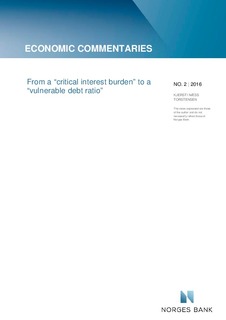| dc.contributor.author | Torstensen, Kjersti Næss | |
| dc.date.accessioned | 2018-08-15T07:54:40Z | |
| dc.date.available | 2018-08-15T07:54:40Z | |
| dc.date.issued | 2016 | |
| dc.identifier.uri | http://hdl.handle.net/11250/2558033 | |
| dc.description.abstract | The debt ratio, measured as total household debt relative to disposable income, has risen markedly over the past 30 years. Changes in structural factors such as relaxation of credit standards and financial innovation have contributed to this rise. Such factors make it difficult to compare debt ratio levels over time. By utilising historical information on interest burdens, this commentary seeks to shed light on the extent to which the current debt ratio represents a source of vulnerability for the Norwegian economy. The analyses are based on a simple, static stress test of the household interest burden. | nb_NO |
| dc.language.iso | eng | nb_NO |
| dc.publisher | Norges Bank | nb_NO |
| dc.relation.ispartofseries | Economic Commentaries;2/2016 | |
| dc.rights | Attribution-NonCommercial-NoDerivatives 4.0 Internasjonal | * |
| dc.rights.uri | http://creativecommons.org/licenses/by-nc-nd/4.0/deed.no | * |
| dc.title | From a "Critical Interest Burden" to a "Vulnerable Debt Ratio" | nb_NO |
| dc.type | Others | nb_NO |
| dc.description.version | publishedVersion | nb_NO |
| dc.subject.nsi | VDP::Samfunnsvitenskap: 200::Økonomi: 210::Samfunnsøkonomi: 212 | nb_NO |
| dc.source.pagenumber | 8 | nb_NO |

